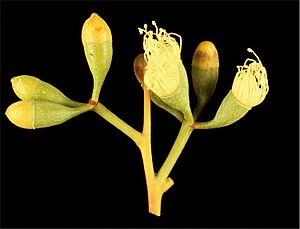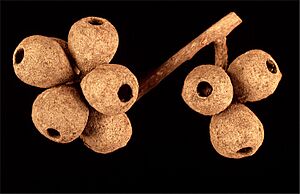Yuna mallee facts for kids
Quick facts for kids Yuna mallee |
|
|---|---|
 |
|
| Eucalyptus jucunda growing in the Shire of Murchison | |
| Scientific classification | |
| Genus: |
Eucalyptus
|
| Species: |
jucunda
|
The Yuna mallee (scientific name: Eucalyptus jucunda) is a type of mallee or small tree. It is found only in Western Australia, meaning it is endemic there. This plant has smooth bark and adult leaves that are shaped like a spear or slightly curved. Its flower buds grow in groups of seven or nine. When it blooms, it has white or cream-coloured flowers. The fruit looks like a barrel or a flattened ball, with a very small opening.
What Does It Look Like?
The Yuna mallee is usually a mallee, which is a type of eucalyptus that grows many stems from a special woody base called a lignotuber. It typically grows to about 3.5 metres (11 feet) tall. Sometimes, it can even grow into a small tree up to 8 metres (26 feet) tall.
Its bark is smooth and can be greyish to creamy brown. Sometimes, near the bottom, the bark might be crumbly, stringy, flaky, or look like ribbons.
Young Yuna mallee plants and new shoots (called coppice regrowth) have leaves that are a bit blue-green (which is called glaucous). These leaves are attached directly to the stem without a stalk (they are sessile) and grow in pairs opposite each other. These young leaves are shaped like an egg or a heart, about 2.5 to 5.7 centimetres (1 to 2.2 inches) long and 1.7 to 3.5 centimetres (0.7 to 1.4 inches) wide.
Adult leaves are shaped like a spear (lance-shaped). They are a dull green on both sides and measure about 6 to 12 centimetres (2.4 to 4.7 inches) long and 1 to 2 centimetres (0.4 to 0.8 inches) wide. These leaves grow on a stalk called a petiole, which is about 1 to 2.2 centimetres (0.4 to 0.9 inches) long.
The flower buds grow in groups of seven or nine in the leaf corners. They are on a main stalk called a peduncle, which can be 0.5 to 1.3 centimetres (0.2 to 0.5 inches) long and sometimes has branches. Each individual bud has a small stalk called a pedicel, about 0.1 to 0.4 centimetres (0.04 to 0.16 inches) long.
When the buds are ready to open, they are shaped like a cylinder or a spindle. They are about 1.1 to 1.3 centimetres (0.4 to 0.5 inches) long and 0.5 to 0.6 centimetres (0.2 to 0.24 inches) wide. Each bud has a cap called an operculum that can be cone-shaped or rounded.
The Yuna mallee flowers from January to April. Its flowers can be white, cream-coloured, or yellow.
After flowering, the plant produces fruit. The fruit is a woody capsule that looks like a barrel or a flattened ball. It is about 0.8 to 1.7 centimetres (0.3 to 0.7 inches) long and 0.8 to 1.5 centimetres (0.3 to 0.6 inches) wide. It has a very small opening, and the parts that open (called valves) are usually at or below the rim.
How It Got Its Name
The Yuna mallee was first officially described in 1964 by a botanist named Charles Gardner. He found a sample of the plant near the Greenough River in 1959.
His description was published in a scientific paper called Journal of the Royal Society of Western Australia. The second part of its scientific name, jucunda, comes from a Latin word. In Latin, 'jucunda' means 'pleasant'.
Where Does It Grow?
The Yuna mallee usually grows in sandy soil on flat, sandy areas. You can find it between the towns of Mingenew and Kalbarri in Western Australia. It grows in several different natural areas, including the Avon Wheatbelt, Carnarvon, Geraldton Sandplains, and Yalgoo biogeographic regions.
Is It Safe?
The Western Australian Government's Department of Parks and Wildlife has looked at the Yuna mallee. They have officially classified this type of eucalyptus as "not threatened." This means it is not currently in danger of disappearing.



